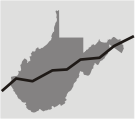
Contents
| WV | DHHR | BPH | OEHP | HSC |
Obesity:
Facts, Figures, Guidelines
Section One - continued
Defnition of Obesity
While the United States and Europe have by far the highest rates of obesity, nonindustrialized countries are also experiencing an increase, particularly those countries undergoing economic transitions and whose residents are becoming more affluent (23). Because obesity is increasingly a worldwide problem, a single international standard has become necessary to monitor its rise. Only with comparable definitions of overweight and obesity can trends be noted and interventions and treatments evaluated.
Definition of Obesity. The World Health Organization adopted the weight classifications developed by the National Institutes of Health (NIH) through an expert panel convened in 1995 that reviewed data from approximately 394 studies to clinically assess the association between weight levels and disease risk (3). These classifications were published in the Clinical Guidelines on the Identification, Evaluation, and Treatment of Overweight and Obesity in Adults in 1998. The panel recommended the use of Body Mass Index (BMI), a measure of weight in relation to height. An individual's BMI is calculated as his or her weight in pounds divided by the square of his /her height in inches times 703. (BMI is also calculated as weight in kilograms divided by the square of height in meters.) Using this measure, the weight categories are
| Underweight | <18.5 |
| Normal | 18.5 - 24.9 |
| Overweight | 25.0 - 29.9 |
| Obesity Class I | 30.0 - 34.9 |
| Obesity Class II | 35.0 - 39.9 |
| Obesity Class III | 40+ |
A single measurement that needs only two factors, weight and height, makes it possible to conduct surveillance on a worldwide basis. There are limitations to BMI, of course. It can be overestimated among persons who are very athletic and have large muscle mass, on the one hand, and underestimated among persons who have lost muscle mass, such as the ill and the elderly. It has been recommended that different BMI cutoff points be used to determine overweight and obesity in certain racial groups (25). In general, however, BMI is considered to be a reliable indication of total body fat content for most adults, regardless of sex. A body mass index chart of height and weight is found on page 8.
BMI-for-Age. Participants at a workshop on childhood obesity convened by the International Task Force on Obesity agreed upon the use of BMI as a reasonable index of excess weight in children and adolescents (26). However, as children grow, their body fat composition changes, so BMI must be applied differently among this population, dependent upon the age of the child. Since boys and girls also differ in their body fatness during the growth period, it is necessary to plot BMI-for-age by sex. In general, BMI tends to decrease during the preschool years, reaching a minimum from ages four to six, and then gradually increases through adolescence into adulthood. Centers for Disease Control and Prevention growth charts for children and adolescents aged two to 20 are used to indicate the percentile into which the child's BMI falls; it is this percentile that determines whether or not the child is considered underweight, normal weight, or overweight. Growth charts are found on page 9.
Cutoff points were established by a committee of experts representing professions that treat obese children and adolescents (27). The cutoff points recommended by the expert committee were
| Underweight | BMI-for-age <5th percentile |
| At risk of overweight | BMI-for-age >or = 85th percentile |
| Overweight | BMI-for-age > or = 95th percentile |
Other Body Fat Measurements. Other body fat measurements include waist circumference, ratio of waist circumference to hip circumference, and skinfold thicknesses. It has been suggested that excess abdominal (visceral) fat poses an additional and independent risk for certain obesity-related diseases such as type 2 diabetes and cardiovascular disease (28); waist circumference and waist/hip circumference ratio can specifically target abdominal fat. Measurements of skinfold thicknesses can be helpful in providing an assessment of percentage of body fat, as well as location of fat. Both these measurements, however, are more difficult to obtain than simple weight and height, and many researchers do not believe them to be superior to BMI as an overall indicator of disease risk from excess adiposity, or fat.
Continue Section One